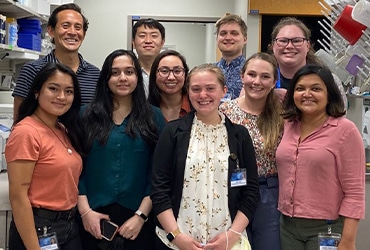PanCAN-AACR Grantee Shows Potential Dual Anti-cancer and Anti-cachexia Benefits of Targeting Perp in Pancreatic Cancer
Cachexia is a muscle-wasting syndrome that is commonly found in pancreatic and other cancer patients and is linked to poor prognosis. There is currently no FDA-approved treatment for cachexia. The research team led by Jason D. Doles, PhD, has identified that the compound 3-methyladenine (3-MA) has anti-cachectic and anti-tumor properties in pancreatic cancer and that its anti-tumor effects are mediated through suppression of a target gene Perp (P53 Apoptosis Effector Related to PMP22). They also show that Perp promotes pancreatic tumor growth and identify it as a potential biomarker/therapeutic target for pancreatic cancer.

Although many drugs have shown efficacy in preclinical studies of cachexia, they have failed in patient clinical trials. Dr. Doles and colleagues postulated that this lack of alignment could be due to a dearth of accurate preclinical mouse models. They developed an aged model of pancreatic cancer cachexia to recapitulate the muscle physiology of pancreatic cancer patients (whose median age of diagnosis is ~65-70 years). Aneesha Dasgupta, PhD, Senior Fellow/Research Scientist in Dr. Doles’ group and the lead author of the study, says, “This study highlights the importance of developing and utilizing appropriate disease models. Our discovery of Perp as a novel tumor promoter and mediator of cancer-associated muscle wasting was made possible by modifying/optimizing an established pancreatic cancer cachexia model.”
In this study, published in the Journal of Clinical Investigation Insight, Dr. Doles and his team implanted cultured mouse pancreatic tumor cells into young (8 weeks old, equivalent to ~20 years in humans) and aged (78-80 weeks old, equivalent to 60+ years in human) mice. While both groups of mice developed pancreatic tumors and cachexia, the authors found substantial transcriptomic differences between young and aged skeletal muscle tissue. When compared to control mice lacking tumors or cachexia, several genes involved in muscle atrophy were differentially expressed in the aged, but not the young, tumor-bearing group.
In a screen for compounds predicted to reverse muscle atrophy, they identified 3-MA (previously shown to rescue muscle wasting in kidney disease models) as a top candidate. The authors showed that 3-MA prevented pancreatic cancer-associated lean muscle loss and decreased tumor growth in aged mice. They also confirmed this observation in a complementary mouse model generated using patient-derived pancreatic tumor cells, supporting the translational potential of this finding for pancreatic cancer patients.
Dr. Doles and colleagues further showed that 3-MA decreased pancreatic tumor growth by suppressing Perp. Perp was expressed at high levels in cancer cell lines and in mouse pancreatic tumor samples, and treatment with 3-MA decreased Perp levels in tumor and muscle and improved mouse survival. The authors also provided evidence that Perp promotes pancreatic cancer growth. PERP protein expression was increased in patient pancreatic cancer lesions relative to surrounding tissue, Perp suppression reduced proliferation of pancreatic cancer cell lines, and Perp deletion abrogated 3-MA’s anti-tumor and pro-survival effects. Building upon this study, Dr. Dasgupta says that the group is now “working towards delineating PERP mechanism-of-action in both tumors and muscle as well as testing the pre-clinical efficacy of blocking PERP activity in tumor-bearing mice.”
This research was supported, in part, by a 2017 Pancreatic Cancer Action Network-AACR Career Development Award that was given to Dr. Doles. While recognizing the research support from AACR and its impact on his career, Dr. Doles remarks, “As a skeletal muscle biologist by training, support from PanCAN/AACR afforded me the opportunity to expand my professional interests to include cancer cachexia. I am truly grateful for this support and believe it was a key factor in defining my present research program.”